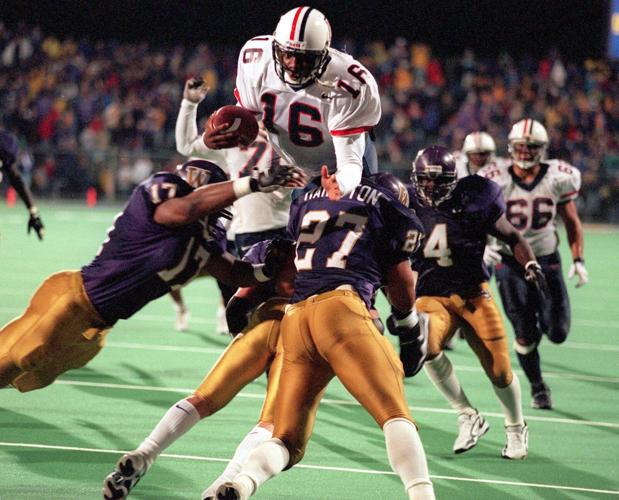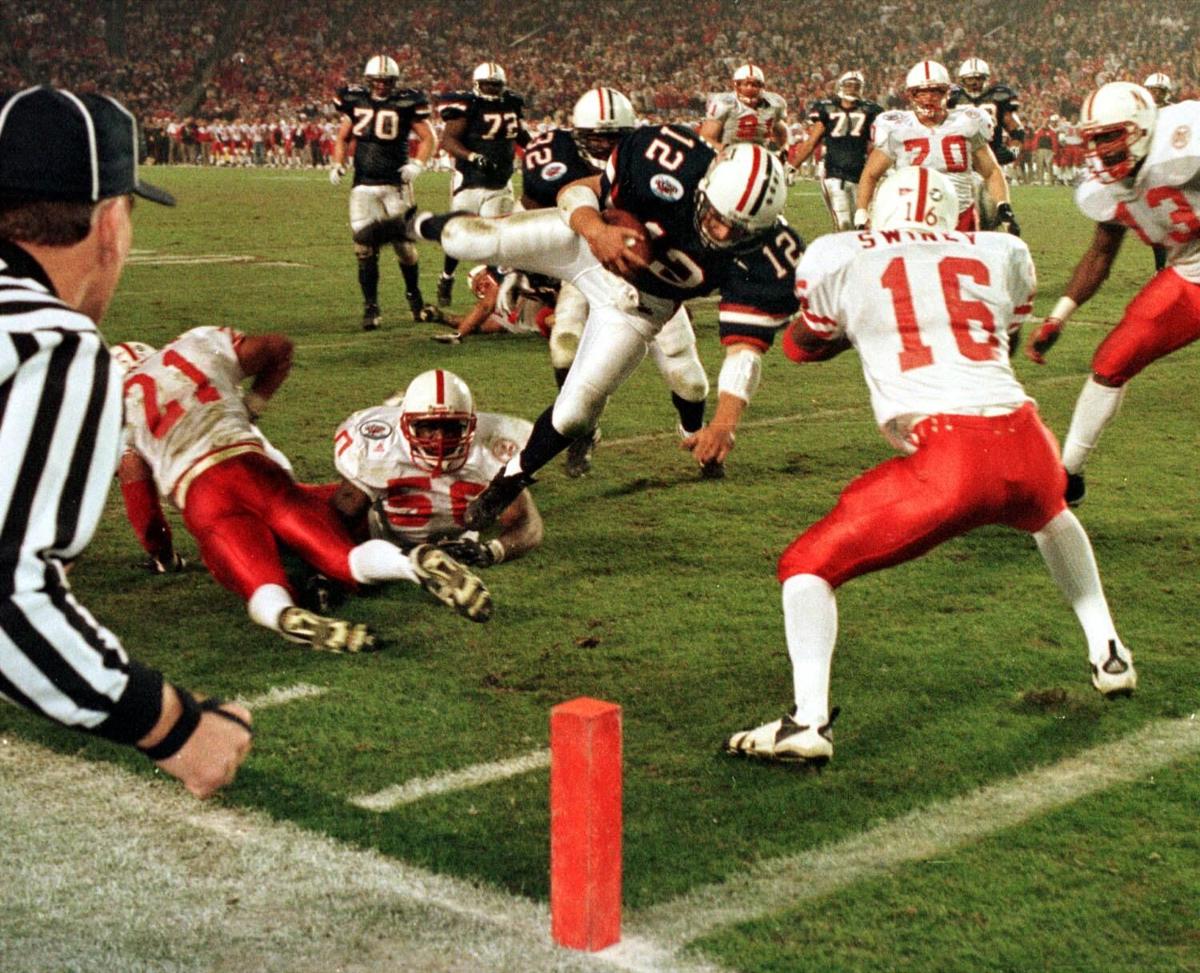As I squeezed to the back of the press box elevator at Arizona Stadium on Oct. 10, 1998, a giddy UCLA assistant football coach announced that “Wildcat fever is over.”
The Bruins had just crushed No. 10 Arizona 52-28 by outscoring the No. 10 Wildcats 21-0 in the fourth quarter.

Going down, right?
Long-suffering Wildcat fans were so dispirited that at the next home game, a mere 39,219 showed up even though Arizona was 6-1 and ranked No. 14 nationally. It was a telling drop from the sellout crowd of 58,738 that showed up for the UA-UCLA game when Rose Bowl chatter engulfed Tucson.
And then everything changed.
Dick Tomey’s Wildcats soon routed No. 12 Oregon 38-3 and reached the final game of the regular season at 10-1, ranked No. 7. In a wild Territorial Cup game, Arizona beat ASU 50-42 and the elevator was suddenly going up, not down.

Arizona's Joe Tafoya tackles Nebraska running back Mic Boettner during the second quarter of the 1998 Holiday Bowl. UA's only loss in 1998 came to UCLA.
UA athletic director Jim Livengood sat in the press box that night with Bud Griest of the Tournament of Roses Committee. All that remained for Arizona to play in the Rose Bowl was to beat ASU and then wait for undefeated and No. 2-ranked UCLA to beat the Miami Hurricanes a week later — a game delayed two months by a September hurricane — and Arizona’s long-awaited dream to play in the Rose Bowl would come true.
Alas, the unranked Hurricanes stunned UCLA 49-45 in a wild comeback in Florida. Instead of playing for the national title against No. 1 Tennessee, UCLA would instead go to the Rose Bowl.
“We’ve still got a chance to have the best season in the history of Arizona football,” Tomey said a day later. “We can go 12-1. There’s so much left to play for.”
Indeed, Arizona was invited to play No. 9 Nebraska in the Holiday Bowl and staged a dramatic comeback to beat the Cornhuskers 23-20. The sting of the early-season loss to UCLA — and of UCLA’s loss to Miami — was eased.
Arizona finished No. 4 in the final AP Top 25.

Arizona quarterback Ortege Jenkins flies over the Washington defensive line in the final moments of the game for the winning touchdown in 1998.
“On our winning drive, we were talking in the huddle, saying, ‘This day won’t ever come again,’” said Arizona’s all-conference receiver, Dennis Northcutt. “We didn’t want to have to live to regret it.”
Said an elated Tomey: “We’ve done everything we can do. I think this team is as good as anyone else.”
The 1998 Wildcats were no fluke. They had perhaps the top offensive line in school history: Edwin Mulitalo, Steven Grace, Bruce Wiggins, Yusuf Scott and Manu Savea didn’t miss a start. They created a space for Pac-12 rushing leader Trung Canidate, who set a modern school record with 1,220 rushing yards.

Arizona's Jeremy McDaniel stretches to catch a pass from quarterback Keith Smith against Washington State in 1998.
In the comeback to beat Nebraska, a 68-yard drive to overcome a 20-16 deficit, that line created space for Arizona to successfully run the ball on eight consecutive plays.
The UA defense, one of the best in school history, did the rest. Linebacker Marcus Bell, who had made 21 tackles to beat ASU in the Territorial Cup, made 14 against the Cornhuskers. All-American cornerback Chris McAlister intercepted a pass to stop Nebraska’s final possession. McAlister also blocked a punt.
Bell, McAlister and defensive tackle Daniel Greer were voted to the All-Pac-10 first team. Tomey called Bell, a no-star recruit from tiny St. Johns in northeast Arizona, “the best we’ve had since I’ve been here.”
UA receiver Brad Brennan, a walk-on, caught a touchdown pass against Nebraska. He put the season in perspective, saying: “We begged for respect all year. Now we won’t have to beg anymore.”

Assistant coach Duane Akina is fired-up as he watches his defense execute during practice in 1998.
Tomey put together one of the leading coaching staffs in UA history for the 12-1 season. His defensive coordinator, Rich Ellerson, is among the best in league history. Defensive backs coach Duane Akina was similarly respected. Linebackers coach Bob Wagner had been the head coach at Hawaii, and first-year offensive coordinator Dino Babers, now the head coach at Syracuse, showed that he was a rising star in the coaching profession.
The ’98 Wildcats played two of the most memorable games in school history, and that’s not counting the Territorial Cup or the Holiday Bowl.

Arizona receiver Dennis Northcutt is lifted by teammates after scoring a touchdown in the second quarter against Northeast Louisiana in 1998.
In late September, Arizona rallied to beat No. 20 Washington in Seattle on quarterback Ortege Jenkins’ unforgettable “Leap By the Lake,” when he somersaulted into the end zone for a 31-28 victory in the final ticks of the game.
And on Halloween, the Wildcats clobbered No. 12 Oregon 38-3, a victory so thorough that Bell said: “I know what we’ve got here. It has all come together.”
The ’98 Wildcats didn’t get to the Rose Bowl — one bad quarter in 13 games cost them that dreamy scenario — but they were clearly the best team in school history.
Photos: 1998 University of Arizona football team – best in school history
University of Arizona, football, 1998
Updated
Arizona's Dennis Northcutt beats Northeast Louisiana University players (3) Dee Jefferson and (25) Brian Taylor to score during the second quarter in 1998.
University of Arizona, football, 1998
Updated
ASU QB Ryan Kealy #8 is being sacked by UA's Mike Robertson #55 as the UA went on to finish the season with an 11-1 in 1998.
University of Arizona, football, 1998
Updated
Arizona's Jeremy McDaniel stretches to catch a pass from quarterback Keith Smith against Washington State in 1998.
University of Arizona, football, 1998
Updated
Arizona's Keith Smith tries for a touchdown in the fourth quarter against Nebraska in the 1998 Holiday Bowl.
University of Arizona, football, 1998
Updated
Arizona's Joe Tafoya (99) tackles Nebraska running back Mic Boettner (4) during the second quarter of the 1998 Holiday Bowl.
University of Arizona, football, 1998
Updated
In this Dec. 30, 1998, file photo, Arizona coach Dick Tomey, left, congratulates linebacker DaShon Polk after the Wildcats 23-20 win over Nebraska in the Holiday Bowl NCAA college football game in San Diego.
University of Arizona, football, 1998
Updated
Running back Trung Canidate gives Arizona Wildcats Coach Dick Tomey the traditional dousing after the Wildcats beat the Nebraska Cornhuskers in San Diego at the 1998 Holiday Bowl.
University of Arizona, football, 1998
Updated
UA's Brad Brennan (13) is caught from behind by Nebraska's Clint Finley (19) while gaining 63 yards on a pass from quarterback Keith Smith during the Holiday Bowl Wednesday Dec.30, 1998 in San Diego.
102822-tuc-spt-jenkins-p1
Updated
Arizona quarterback Ortege Jenkins flies over the Washington defensive line in the final moments of the game for the winning touchdown in 1998. Jenkins will be added to the UA’s Ring of Honor on Saturday.
University of Arizona, football, 1998
Updated
Assistant coach Duane Akina is fired-up as he watches his defense execute during practice in 1998.
University of Arizona, football, 1998
Updated
Arizona receiver Dennis Northcutt is lifted by teammates after scoring a touchdown in the second quarter against Northeast Louisiana in 1998.
University of Arizona, football, 1998
Updated
UA's Rafell Jones #1, with his teammates, celebrates an interception at 1st quarter against Oregon in 1998.
University of Arizona, football, 1998
Updated
Arizona's Kelvin Eafon (38) scores the Wildcats' first touchdown in the first quarter of Saturday's game at Arizona Stadium against the UCLA Bruins in 1998.
University of Arizona, football, 1998
Updated
Arizona's Manuia Savea #67 and Leon Callen #29 celebrate after Callen scored in the 4th qtr against Oregon State in 1998.
University of Arizona, football, 1998
Updated
Arizona's Kelvin Eafon #38 scores during 3rd qtr. against Oregon in 1998.
University of Arizona, football, 1998
Updated
Arizona tailback Trung Canidate outruns Stanford's (92) Marcus Hoover in the first quarter against Stanford in 1998.
University of Arizona, football, 1998
Updated
Arizona's Kelvin Eafon #38 goes up and over the top for a touchdown in the second half against Washington State in 1998.
University of Arizona, football, 1998
Updated
Arizona running back Trung Canidate gets interviewed by a Fox Sports analyst after UA's win over ASU in 1998.
University of Arizona, football, 1998
Updated
Arizona quarterback Keith Smith tries to escape the grasp of Oregon's Chris Vandiver during the third quarter in 1998.
University of Arizona, football, 1998
Updated
Arizona's Yusuf Scott (72) is getting to know Oregon middle linebacker Aaron Cheuvront (34) a little better in 1998.
University of Arizona, football, 1998
Updated
Arizona's Daniel Greer (right) sacks NLU quarterback Andre Vige during the third quarter as UA's Idris Haroon (left) helps out in 1998.
University of Arizona, football, 1998
Updated
Arizona running back Trung Canidate (30) runs through a hole in Washington State's defense and heads for the goal line in the game's first half in 1998.
University of Arizona, football, 1998
Updated
Arizona coach Dick Tomey, right, and players lift the Holiday Bowl trophy after Arizona defeated Nebraska 23-20 on Dec. 30, 1998 in San Diego.
University of Arizona, football, 1998
Updated
Washington State Cougars' RB DeJuan Gilmore (1) is stopped in the first quarter by Wildcat defenders Keoni Fraser #56, and Eli Wnek in 1998.
University of Arizona, football, 1998
Updated
Arizona tight end Mike Lucky (88) downs Washington State Cougar Grady Emmerson (44) as he heads for the end zone during first half action in 1998.
University of Arizona, football, 1998
Updated
Arizona's Brad Brennan runs for the touchdown along with UA #15 Jeremy McDaniel during 1st quarter against Oregon in 1998.
University of Arizona, football, 1998
Updated
Arizona tight end Paul Shields #32, hugs #30 Trung Canidate after Canidate scored a touchdown in the first half against the Washington State in 1998.
University of Arizona, football, 1998
Updated
Arizona running back Kelvin Eafon stretches over the goal for a touchdown with 40 seconds left in the third quarter against Oregon in 1998.
University of Arizona, football, 1998
Updated
Arizona's Jeremy McDaniel tries to catch a pass ahead of Oregon's Rashad Bauman in 1998.
University of Arizona, football, 1998
Updated
Arizona playerr Ortege Jenkins, Keith Smith, Dennis Northcutt, Jeremy McDaniel and Trung Canidate in 1998.
University of Arizona, football, 1998
Updated
Arizona defensive coach Dwight Akina shouts orders to players during the second quarter against Washington State in 1998.
University of Arizona, football, 1998
Updated
Arizona running back Trung Canidate runs towards the sidelines as Oregon's Michael Fletcher (right) turns to pursue him in 1998.
University of Arizona, football, 1998
Updated
Arizona running back Trung Canidate runs against the Washington State Cougars at Arizona stadium in 1998.
University of Arizona, football, 1998
Updated
ASU's Kareem Clark #26, pulls down UA wideout Dennis Northcutt as he hauls in a pass for a first down in the first half in 1998.
University of Arizona, football, 1998
Updated
Arizona fans during UA vs. Oregon football game in 1998.
University of Arizona, football, 1998
Updated
Arizona's Joe Tafoya #99 is sticking it to Oregon QB Akili Smith in the first half of action in 1998.
University of Arizona, football, 1998
Updated
Arizona running back Trung Canidate runs behind his offensive line against Arizona State in 1998.
University of Arizona, football, 1998
Updated
Arizona's Trung Canidate gets a little help from Paul Shields during the third quarter of the UA vs. Oregon in 1998.











